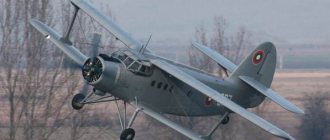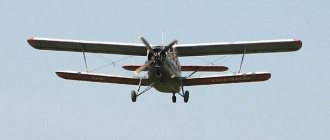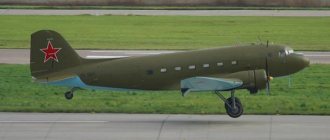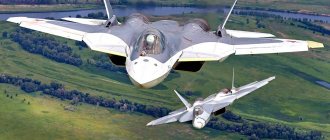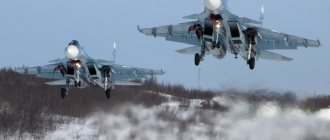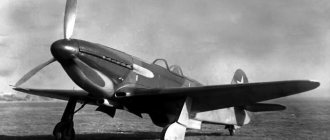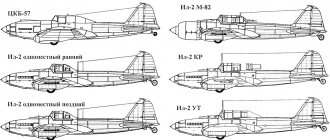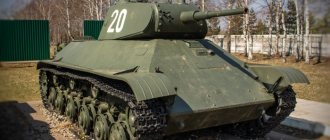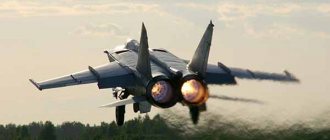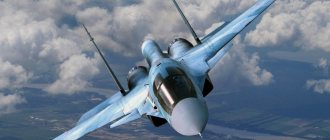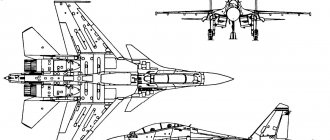| Be-6 | |
| Be-6 at the Ukrainian State Aviation Museum | |
| Role | Naval reconnaissance and patrol aircraft |
| Manufacturer | OKB Beriev |
| First flight | 1949 |
| Retired | Late 1960s |
| Primary users | USSR Navy People's Liberation Army Navy |
| Produced | 1949–57 |
| Number of built | 123 |
| Developed in | Beriev Be-12 |
The Beriev Be-6
(USAF/DoD reporting name
"Type 34"
, [1] NATO reporting name
"Madge"
[2]) was a flying boat produced by the Soviet Beriev Design Bureau. It was capable of carrying out a wide range of missions, such as long-range maritime reconnaissance, coastal and supply line patrols, torpedo bombing, mine laying and transport operations.
History of operations[edit]
A-4B of the US Navy intercepts a Be-6 off the coast of Japan, 1964.
The Be-6 was built from 1949 to 1957 at the Beriev plant in Taganrog. The aircraft had 19 variants during its production run, and 123 aircraft were eventually built. Since the requirements for Soviet naval aviation did not change quickly, the reliable Be-6 remained in service until the late 1960s. Some aircraft have ceased service as civilian unarmed transport in Arctic regions. One survivor is preserved at the State Aviation Museum of Ukraine in Kyiv, Ukraine. The Be-6 Beriev, operated by the People's Republic of China PLAN, has proven useful in patrolling the long coastline and vast territorial waters off the coast of China. During the 1970s, the original Shvetsov radial engines began to wear out beyond the possibility of replacement, so several aircraft were converted with WoJiang WJ-6 turboprop engines, with new nacelles for new service life, and were renamed Qing -6
. [3]
AT THE JOINT OF TWO ERAS
The proposals had the desired effect, and the appropriate conclusions were drawn fairly quickly. Reviews of the Be-6 aircraft from the first to fourth series, which underwent military tests from July 1953 to April 1954 at the base of the 977th omdrap aviation of the Black Sea Fleet in Poti, were already quite favorable.
Combat pilots noted that the aircraft was easy to fly and accessible to pilots of average qualifications, was well controlled when flying at speeds from 200 km/h to maximum, glides steadily over the entire speed range, and lands without a tendency to separate from the water or oscillate during the run.
The aviators highly appreciated the rich set of equipment for its time, and primarily the radar. The ASh-73 motors proved to be quite reliable, and their adjustment did not cause any particular difficulties for the technical staff.
The complaints were primarily caused by the low resistance of the aircraft structure to corrosion and the leakage of the boat deck, the difficulty of flying in difficult weather conditions due to deficiencies in the cockpit equipment and the unsatisfactory performance of the anti-icing system of the front canopy windows.
In addition, quickly leaving pilots' workplaces with a parachute fastened in emergency situations turned out to be almost impossible. But the most important drawback, without exception, was the lack of means of searching for submarines underwater.
Upon completion of the tests, the opinion was finally established that the Be-6 should be used primarily for long-range maritime reconnaissance, as well as for searching and destroying submarines on the surface. The aircraft could be used as a search and rescue aircraft, as well as for laying minefields and bombing weakly protected sea and coastal targets.
In general, in terms of combat effectiveness, the Be-6 significantly surpassed the outdated Catalina, which still remained the main naval reconnaissance aircraft in the USSR. However, as military tests have shown, in everyday operation the Be-6 turned out to be much more complex than the American amphibian.
The wishes and comments of the military were taken into account, and the aircraft of the latest series, starting with No. 5601602, received an air-thermal anti-icing system for the wing and tail, new pilot seats, as well as a system for pressurizing fuel tanks with neutral gas. It was possible to improve the layout of the nose of the aircraft.
A total of 123 vehicles were produced from 1952 to 1957.
OKB-49 began improving the Be-6 immediately after the vehicle was put into production. In 1953, the possibility of installing a mounted amphibious landing gear on production aircraft was explored.
Basic data of seaplanes of the Be-6 family
The first major modification of the base aircraft was the search and rescue version, designated Be-6SS (rescue service). The modernization was carried out by removing the cannon installations, the deck gunner's workplace, photographic equipment, the berth on the starboard side and the landing seats on the left side of the boat in the compartment between frames No. 19 and No. 23.
To replace the removed equipment, special radio-technical means of search and detection were installed - the Shtyr-A-4 receiving device (received signals from the Kamelia emergency radio stations) and an attachment to the ARK-5U "Pritok" radio compass, means of selecting and receiving on board victims and providing assistance to them first aid.
In total, the seaplane could accommodate 15 people, of whom 12 were seated and three were in hanging berths. The crew included a paramedic, for whom a seat, a work table and a special cabinet with a set of necessary tools and medicines were installed.
The rescuer was tested from June 11 to July 18, 1958 at the base of the 977th Black Sea Fleet Air Force squadron in Poti.
But the aircraft did not go into production, especially since already on December 22, 1960, the naval aviation command approved new requirements for search and rescue aircraft. The experience gained during the conversion of the Be-6 into the Be-6SS was very useful in the creation of the Be-14 and Be-12PS.
The only modification that reached mass production was the Be-6PLO anti-submarine defense aircraft. On it, to detect submarines in an underwater position, the first domestic system of radio-hydroacoustic buoys (RSB) “Baku” was placed, which included an aircraft receiving automatic radio device SPARU-55 “Pamir” and a set of 18 non-directional passive buoys RSL-N “Iva”.
Externally, the Be-6PLO differed from the basic version in the absence of the Il-K6-53Be aft firing unit, in the place of which there was a magnetically sensitive unit of the AMP-56 “Chita” aircraft magnetometer.
Tests were carried out from July to November 1953 on the Black Sea based on Lake Paleostomi and were continued on the Barents Sea. The target was the latest diesel submarine of that time, Project 613, which at a speed of six knots was confidently detected at depths of up to 50 m and distances of 1500 - 2000 m.
The Be-6PLO in the search version carried an RSL on 16 external hardpoints. When carrying out strike missions, cassettes with PLAB-MK depth charges were suspended in their place, each of which could hold 57 bombs.
Conversion of the Be-6 into an anti-submarine aircraft began in the Black Sea and Baltic fleets in 1954, in the North in 1955, in the Pacific Ocean in 1956-1957.
The last modification of the seaplane was the Be-6 “Liner” (product “KL”), on which in 1965 - 1967. Work was carried out to install a communication system with submerged submarines. But in June 1966, work was suspended in order to continue on another machine (serial number 4601403). The modified Be-6 was transferred for testing to the 318th separate anti-submarine aviation regiment of the Black Sea Fleet in Donuzlav in 1967. Based on the test results, the topic was closed.
In addition to Navy aviation, the Be-6 served in civilian service - in Polar Aviation. From 1955 to 1957, seven flying boats were re-equipped at plant No. 86 in Taganrog. All weapons were removed from them and additional fuel tanks were installed.
In 1959 - 1960 about 20 vehicles from the Navy were transferred to China, where they outlived their counterparts from the USSR for a long time.
On August 22, 1951, by order of the Minister of the Navy, the Be-6 long-range naval reconnaissance aircraft was put into service. By September 1953, there were only 20 production Be-6s in naval aviation. In the same month, the personnel of the 17th omdrae of the Baltic Fleet began retraining for new equipment.
In the Black Sea Fleet, the 977th odrap began developing a new flying boat at the beginning of 1953. From July 20 to August 18, 1954, the regiment's crews transported 18 Be-6s to the Pacific Fleet.
By mid-1955, in all fleets, the retraining of flight personnel on the Be-6 was basically completed, although the 289th Air Regiment of the Pacific Fleet completely switched to new vehicles only by August 1957.
Having begun their service in naval aviation as long-range reconnaissance aircraft, the Be-6 immediately became involved in the unfolding Soviet-American confrontation at sea. The Pacific sailors flying reconnaissance into the Sea of Japan immediately became targets of interception by fighters from the US 7th Fleet. The Yankees gave the rookie their codename Magda.
The combat training course for naval reconnaissance aviation units traditionally included bombing day and night in simple and adverse weather conditions and high-altitude torpedo throwing. Now the center of gravity of studies began to shift towards reconnaissance training and flights to maintain the operational regime in the area of responsibility of their fleets.
Such flights usually lasted 8-10 hours, but the regiments had aircraft with additional tanks that could stay in the air for up to 20 hours. In this case, there were two crew on board. The tactical radius of the Be-6 made it possible to survey large areas of water. North Sea flying boats often reached the island of Spitsbergen on such flights.
The crews of the Northern Fleet reconnaissance regiment were involved in supporting nuclear weapons tests carried out on the Novaya Zemlya archipelago in the fifties. Their task was aerial reconnaissance over the water areas adjacent to the test site, but sometimes the Be-6 was tasked with taking air samples from a radioactive cloud.
Despite the successful start, the Be-6's career as a naval reconnaissance aircraft was short-lived. With the advent of the Il-28R jets in 1954, the flying boat in this capacity was no longer suitable for the naval aviation command.
Equipping aircraft with special means of searching for submarines immediately raised new questions. There was no experience in using these systems; search tactics and interaction between anti-submarine aircraft and shipborne search strike groups (SSUG) had not been worked out.
Gradually, the aviators accumulated the necessary experience, developed search and tracking schemes, and conducted numerous research exercises. It was on the Be-6 that tactical techniques such as the “cross” and the enveloping barrier from the RSL, which later became standard for anti-submarine aircraft, were first practiced.
The onboard equipment of the flying boat was also improved. In 1960 - 1962 On the aircraft of the Black Sea Fleet and Northern Fleet, an automatic navigation device ANP-1 “Azov” was installed, which provides dead reckoning of the aircraft’s path and makes it possible to reach the point where the device was turned on. With the use of ANP-1, it became possible to aim when attacking a boat in an underwater position, and after installing Doppler ground speed and drift angle meters DISS-1 on several vehicles, combat maneuvers were even more simplified.
The first version of the PVU-S “Siren” sighting computer device was tested on the Be-6. Subsequently, after significant modifications, this system was transferred to the Be-12. Beginning in 1962, the Be-6 began to be equipped with new, more sensitive APM-60 Orsha magnetometers.
One of the first detections of a submarine occurred in 1958 in the Northern Fleet. The Be-6 crew monitored the submarine using the RSL for 4.5 hours, and then transferred contact to surface ships. In 1959, North Sea pilots again discovered a foreign submarine. Three Be-6PLOs took part in tracking it.
The search areas expanded, and in 1957, regiments on Sakhalin (Lake Chibisan) and Kamchatka (Yagodnaya Bay) were re-equipped with the Be-6. The good seaworthiness of the boat has repeatedly helped naval pilots in critical situations. For example, the crew of captain Nakhodny stranded on the open sea at night due to engine failure. The plane was found 14 hours later and safely towed to the base.
With the beginning of the 1960s, the fleet was already able to conduct large-scale anti-submarine operations, and by order of the USSR Minister of Defense dated March 23, 1961, the naval long-range reconnaissance regiments on the Be-6 were renamed anti-submarine regiments. The population included two anti-submarine squadrons and one search and rescue squadron.
On March 23, 1963, the Mi-4PL anti-submarine helicopter discovered an unknown submarine at the Northern Fleet combat training ground. The Be-6 organized tracking of her together with helicopters and surface ships. Despite the boat’s attempts to break away from the pursuit and its use of hydroacoustic interference, the tracking continued for 33 hours.
Having used up the battery capacity, the submarine surfaced. It turned out to be the English diesel submarine S07 Sea Lion.
After this incident, the “probable enemy” made the appropriate conclusions, and only nuclear submarines began to conduct reconnaissance in the Barents Sea. It was much more difficult to keep track of them, and the Be-6 could no longer cope with this task. By 1968 - 1969 in the aviation anti-submarine regiments they were replaced by the Be-12 and Il-38.
We recommend reading
- INSTEAD OF A HAMMER - A CLAMP Often there is a situation when you need to hammer a nail in a place where you cannot swing a hammer - inside a shelf, drawer, cabinet. To do this, sometimes they resort to a “workaround” maneuver:...
- MOTORCYCLE TRAILER Many motorcycle owners strive to use their existing vehicles as efficiently as possible. When constructing various buildings, landscaping garden plots...
Technical characteristics (Be-6) [edit]
Data from
Encyclopedia of Russian aviation "Osprey" for 1875–1995. [4]
General characteristics
- Crew:
8 - Length:
23.5 m (77 ft 1 in) - Wingspan:
33 m (108 ft 3 in) - Height:
7.64 m (25 ft 1 in) - Wing area:
120 m2 (1300 sq ft) - Profile: root:
NACA 23020;
advice:
NACA 23010 [5] - Empty weight:
18,827 kg (41,506 lb) - Gross weight:
23.456 kg (51,712 lb) - Maximum takeoff weight:
29,000 kg (63,934 lb) - Maximum landing weight:
20,928 kg (46,138 lb) - Powerplant:
2 × Shvetsov ASh-73TK 18-cylinder air-cooled radial piston engines, 1,800 kW (2,400 hp) each - Propellers:
4-blade constant speed propellers V-3BA-5.
Performance
- Top speed:
414 km/h (257 mph, 224 kn) at 1,800 m (5,906 ft)
377 km/h (234 mph; 204 kn) at sea level
- Cruise speed:
280 km/h (170 mph, 150 kn) at 2,000 m (6,562 ft) - Landing speed: '
147 km/h (91 mph; 79 kn) - Range:
4,800 km (3,000 mi, 2,600 mi) - Service ceiling:
6,100 m (20,000 ft)
Climb
time :
5,000 m (16,404 ft) in 20 minutes
Armament
- Weapons:
5 × 23 mm (0.91 in) nr-23 autocannon in 3 remote-controlled turrets - Bombs:
General ammunition,
or - 2 x 1,000 kg (2,205 lb) torpedoes, or
- 8 min
Design
The design is all-metal, with the exception of the fabric covering of the rudders and ailerons. To increase survivability, the hull is divided into eight waterproof compartments.
Seagull wing. Air-thermal deicers are installed in the leading edge. TsAGI type flaps, three per wing. Ailerons are slotted, differential, with 100% weight balancing. The vertical tail is two-finned.
The power plant is two ASh-74 engines installed in the wing bends. Propellers V-3BA-5 - pulling, four-bladed, automatic, weathervaned, hydromechanical. Diameter - 5.056 m. Fuel tanks (22 pcs.) are soft, installed in the wing.
Maneuvering on the water is carried out using the ship's rudder mounted on the rear gear.
Underwing floats on cantilever struts. Each float is divided into four waterproof compartments to increase survivability in case of damage, since with such an aircraft design, the loss of a float means the loss of the aircraft due to the inability to overcome the roll after the wing goes under water and its subsequent destruction.
The aircraft is controlled by cables and rods, duplicated for the elevators. An electric autopilot AP-5 is installed.
Anti-icing system - air-thermal de-icers of the leading edges of the wing, electric heating of the front windows of the cabin, air-thermal de-icers powered by four gasoline heaters. Alcohol washers were installed for the front windows of the navigator's cabin and the propeller blades. The windows are equipped with mechanical windshield wipers and a fresh water washer (navigator's glass).
In the modeling industry[ | ]
Essentially only three plastic models of the Be-6 were produced. Since the mid-70s. A 1:72 scale model of the Be-6 was produced by the Plasticart national enterprise in the GDR. Subsequently, the same set was sold under the brands Master Model, NU-BEE, Playfix, Revell, REIFRA.[9][10]; this set was not distinguished by its exact geometric correspondence to the prototype, nor by the richness of detail[11].
A more advanced model has been produced since 2015 by the Chinese, also on a scale of 1:72; a model in scale 1:48 is also announced[12][11].
A Ukrainian model on a scale of 1:144 is also known.[13]
Additional equipment[ | ]
- The electrical equipment of the aircraft included two generators and a battery. Marine equipment - two floating and one bottom anchor with a winch, grappling hook, hooks, lines, megaphone;
- Emergency equipment - two rescue boats, containers with food and water supplies, an emergency radio station;
- Photographic equipment for aerial photography through the bottom or over the side;
- Oxygen equipment for flights at altitudes above 4000 m consisted of eight-liter oxygen cylinders with oxygen devices for each crew member and five portable oxygen devices.[2]
Literature
- Shavrov V.B.
History of aircraft design in the USSR. 1938-1950. - 4th ed. - M.: Mashinostroenie, 2002. - 554 p. — ISBN 5-217-03103-4.
| Ship ejection | KOR-1 (Be-2) • KOR-2 (Be-4) | |
| Jet boats | R-1 • Be-10 | |
| Amphibians | Be-8 • Be-12/Be-14 “Chaika” • A-40 | |
| Multi-purpose civilian | Be-103 • Be-200 | |
| Land-based | An-30 ¹ • Be-30/Be-32 • Tu-142MR "Eagle" • A-50 ² • A-100 | |
| Experimental aircraft | Be-1 • VVA-14 • A-60 | |
| Unrealized projects | P-42 • Be-2500 • A-42 “Albatross” • Be-101 | |
| Notes: ¹ jointly with OKB im. O. K. Antonova; ² in collaboration with the Vega concern | ||
